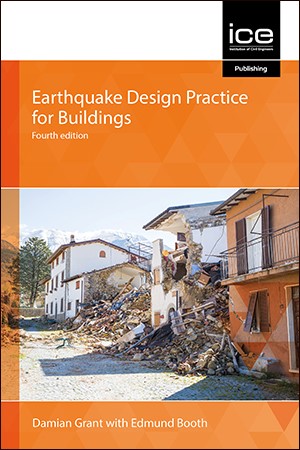Earthquake Design Practice for Buildings, Fourth edition
Earthquake Design Practice for Buildings covers the main principles and design rules that are used to design buildings to resist the effect of earthquakes. It offers comprehensive, practical and easy to read advice on the technical issues that have to be considered in the seismic design of buildings. This indispensable guide outlines the principles of structural dynamics used to establish how a building and its foundations respond to strong ground shaking. Extensive advice is provided on the choice and design of structural forms and materials which produce practical, affordable and attractive buildings resilient to earthquakes.
Now in its fourth edition and written by two experienced seismic engineers, this book has been updated to take into account the many developments in seismic design practice in recent years, including
- updates to international seismic design standards, along with new editions of US design standards, upcoming changes to Eurocode 8, and a comparison with Indian and Chinese code requirements
- a new chapter on seismic performance objectives for new and existing structures, and the latest developments in performance-based earthquake engineering (PBEE)
- expanded coverage on the design of masonry and timber structures
- design of specific seismic-protective technologies, such as base isolation and supplemental damping, and the role of ‘non-structural’ building components in delivering resilient, damage-resistant seismic design
- a revised introduction on the wider technical and socio-economic factors affecting earthquake resilience.
Containing information about the updated international seismic standards, Earthquake Design Practice for Buildings is directed at practising engineers and advanced-level students seeking a broad survey of the latest developments in seismic engineering. It also appeals to those who have a sound general knowledge of structural design but who may be unfamiliar with the problems of providing earthquake resistance.
Want to find out more on designing earthquake-resistant buildings in seismic areas around the world? Read Damian Grant's, author of Earthquake Design Practice for Buildings blog: Beyond life safety: how to make sure our buildings behave themselves in an earthquake.
Book Reviews
This book succeeds in achieving the difficult balance of being relatively straightforward to follow for an engineer with limited background in the subject, whilst being very informative and engaging for more experienced readers who want to update their knowledge and skills in seismic design. Although the main focus of the book is on the behaviour, design and assessment of buildings, it also raises awareness of the wider economic and societal considerations related to earthquake resilience. The book meets the needs of a wide international audience, as there is emphasis on explaining the underlying fundamental concepts without reliance on a specific code of practice. Nonetheless, the basis and procedures of a number of international design standards are presented, discussed and compared, including those from the European, North American, Indian and Chinese seismic codes.
Ahmed Elghazouli FREng, Professor of Structural Engineering, Imperial College London, UK
Special features of this edition which will make it particularly valuable to engineering designers are:
- its timely account of the Eurocodes, now finally becoming published documents and soon to become mandatory in some areas, with which Edmund Booth has been closely involved
- the excellent chapter on conceptual design, setting out some fundamentals which should be thought about while a building’s form and siting are still being developed, and which architects as well as engineers will find illuminating
- a valuable new chapter on the assessment and strengthening of existing buildings, an activity whose importance is already growing in many countries, as we look for ways to protect our urban centres from future earthquake disasters
- an excellent state of the art on seismic isolation, rightly identified by the authors as ‘an idea whose time has come.
Professor Robin Spence, President, European Association for Earthquake Engineering, Cambridge, UK
This new edition provides the latest knowledge of earthquake engineering for civil engineering designers, especially those engaged on international projects. The book is a very comprehensive reference, with new sections on non-structural components and sesmic protective technologies.
Bin Wang, Sichuan University, China
Damian Grant is an Associate Director in Arup’s Advanced Digital Engineering group, in London, UK, and leads the group’s earthquake engineering team. He also lectures on the MSc course in earthquake engineering at Imperial College London, UK.
Edmund Booth has for 25 years run his own consultancy in the UK, specialising in seismic design, assessment and code development. He has been a visiting professor at the University of Oxford,UK, is a fellow of the Royal Academy of Engineering and lectures at Imperial College London, UK.
01. The nature of earthquake risk
02. Earthquake hazard
03. Seismic codes of practice and performance objectives
04. Initial seismic design considerations
05. Seismic analysis and design methods
06. Analysis of soils and soil-structure interaction
07. Foundations and retaining structures
08. Reinforced concrete design
09. Steelwork design
10. Masonry design
11. Timber design
12. Non-structural building components and contents
13. Seismic-protective technologies
14. Assessment and strengthening of existing buildings


No customer reviews